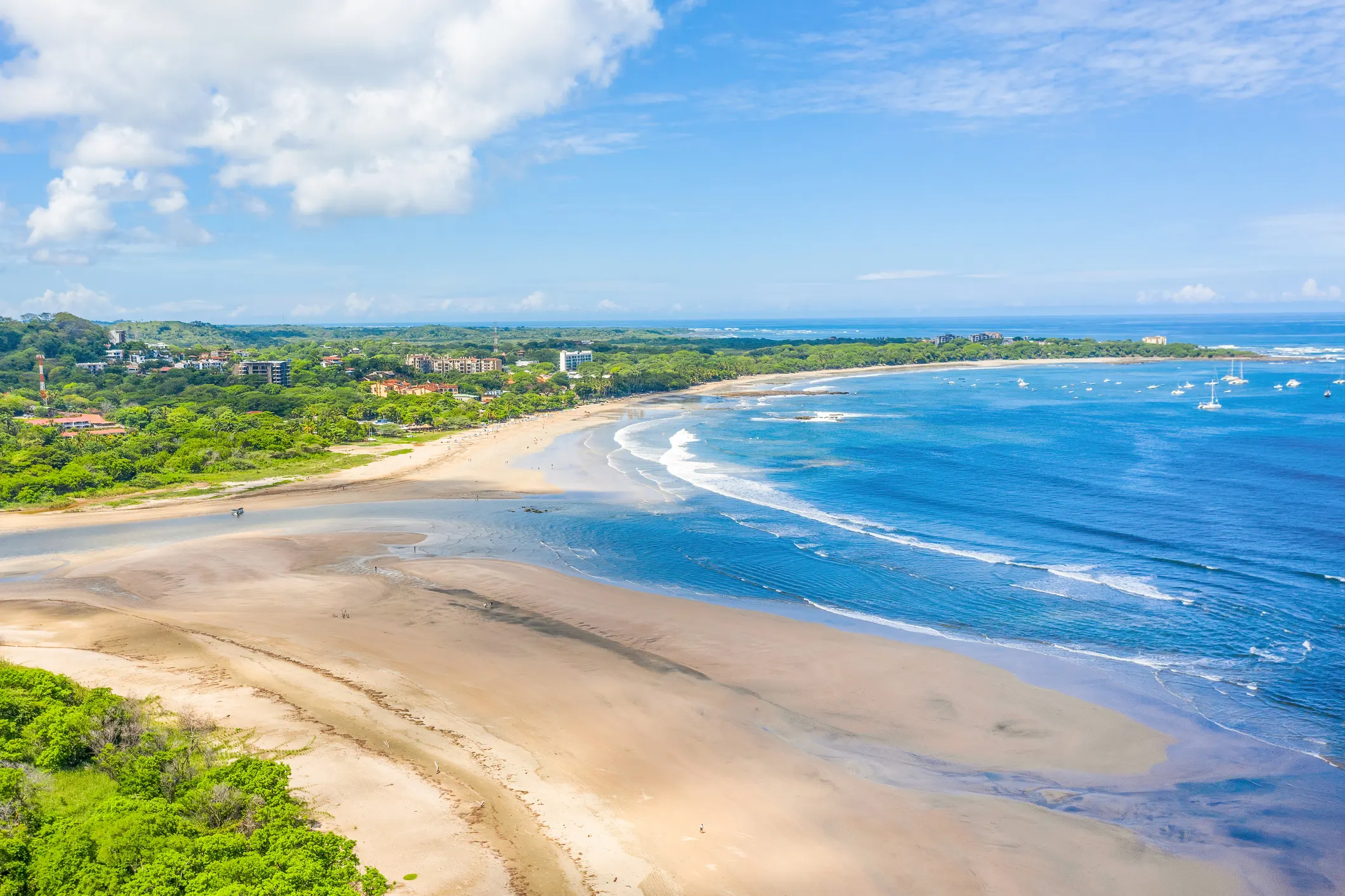Costa Rica’s Billionaire Playground Reopens
8 min readIt was morning in Costa Rica, and I was gazing out over the Pacific Ocean from the terrace of a sprawling, hillside villa. Just below me was Playa Flamingo: a mile-long arc of pristine beach.
From my terrace, I could make out early-morning swimmers in glistening waters and a couple strolling barefoot on powder-soft sand. The air was filled with birdsong, punctuated only by the gentle rustling of palm trees and the rhythmic crashing of waves. It was February, and I’d just arrived in this region because exciting things are happening along the coast here.
For years, the northwest Pacific coastline of Costa Rica has been a playground of billionaires and celebrities. You’ll find high-end resorts and upscale marinas. Ocean-view homes sell for millions—even tens of millions—of dollars. Twitter co-founder Jack Dorsey has a house here. So does Facebook boss Mark Zuckerberg—reportedly. Rumors say Tom Brady and Andre Agassi own here, too.
But a new set of affluent buyers and renters are starting to flock to this region. These aren’t the super-rich—they aren’t in the market for multi-million-dollar mansions—but they do want high-end amenities, and they’re willing to pay to get it.
This is a pattern I’ve seen play out before in places like Cabo and the Algarve region of Portugal. And each time, it led to huge capital appreciation and rental income for real estate investors who got in ahead. That’s exactly what members of my Real Estate Trend Alert group and I are doing now in this part of Costa Rica… we’re getting in ahead.
Costa Rica is a natural paradise—a land of stunning beaches, verdant jungles, and rushing rivers. Around a quarter of this country is made up of protected areas, like national parks or forest reserves.
Since the 1980s, the authorities have played on this, cranking out tourism slogans like “Costa Rica, it’s only natural.” These pioneering eco-tourism campaigns have been wildly successful. Today, Costa Rica is the most visited country in Central America. It had 2.47 million visitors in 2023—huge numbers for a country with a population of just 5 million.
Natural beauty aside, there’s another reason millions of people come here: Costa Rica is among the safest, most stable countries in the region. The army was abolished in the 1940s. And the money other countries spend on the military goes into education and a top-rated national healthcare system here.
Life expectancy averages 79.28 years. That beats out the US by a couple years. And in northwest Costa Rica, you’ll find one of the world’s five “Blue Zones”—regions that are home to the healthiest and longest-lived people on the planet.
Way back before Costa Rica’s tourist boom, the country’s northwestern province of Guanacaste was a sleepy region of empty beaches and good surf breaks. It fit the bill if you were looking for a little adventure and fun in the sun, but getting to this idyllic spot took some doing.
The drive from the capital city took four or five hours on bumpy roads. It set you up for the lack of frills when you arrived. Your digs were small mom ‘n’ pop hotels. Your dining choices were limited.
But a savvy group of hotel and real estate developers saw the appeal of this endless-summer location. The Four Seasons pumped more than $200 million into a top-quality golf course, rooms and suites, and hillside villas. Investors involved in the Four Seasons, as well as the Hacienda Pinilla and Reserva Conchal resorts, were then instrumental in persuading Delta to fly to Guanacaste’s international airport in the provincial capital, Liberia.
This transformed the region. In 2003, Liberia airport saw 50,000 passenger arrivals. By 2022, the numbers had hit almost 1.4 million. (While the figures for 2023 haven’t yet been released, they’re expected to exceed this record high.)
Today, Liberia airport is easy to get to from virtually anywhere in North America. More than a dozen airlines operate direct flights from Liberia to 20 destinations, including Los Angeles, Dallas-Fort Worth, Miami, New York, Toronto, and Atlanta.
Visit Guanacaste today and you can stay in hotels with 5-star service. The Four Seasons has since been joined by JW Marriott, Ritz-Carlton, and the Westin. An investment group from Dubai is about to begin construction on a super-luxury project called One&Only Papagayo. They claim it will be a 7-star resort.
Meanwhile, a Waldorf Astoria hotel and residential community is set to open this year. It will feature estate homes, condos, and a 190-room hotel resort. Two-bed condos there reportedly start at $1.62 million, and four-bed estates at $5.31 million.
As investment came to this part of Costa Rica, towns along the coast of Guanacaste grew quickly. Tamarindo, once a little-known haven of surfing nomads, became an internationally renowned beach and surf destination. In the once-rustic beach town of Playas del Coco, you’ll now find sushi bars and gourmet supermarkets. And in Playa Flamingo, where I recently stayed, an upscale marina just recently opened. This first phase of the project reportedly cost $12.7 million and further phases are planned, with the total investment estimated at $50 million.

©iStock/Caroline Brundle Bugge
All this new investment helped spread the word about Guanacaste. This, along with the increased flight availability, has attracted a new kind of affluent visitor and expat. Think doctors, lawyers, executives, self-made entrepreneurs, and work-from-anywhere professionals.
Since they started coming, real estate here has been heating up right alongside the hospitality development. With new construction in popular towns like Playas del Coco, Playa Flamingo, and Tamarindo, high-end condos go for $500,000 and up, penthouses for over a million…
All that’s not to give a false impression of this region. Far from overdeveloped, Guanacaste retains a rustic, rural charm. It’s a family-oriented destination where life is lived at a laidback pace. But the patterns I see playing out in Guanacaste remind me of the trends I tracked in Cabo.
Cabo was once a destination for celebrities and the elite. Then new affluent visitors and long-term residents started coming in big numbers. They weren’t in the market for mansions, but they wanted luxurious, resort-style amenities and a perfect location—and they were (and are) willing to pay to get it.
I tracked this trend in Cabo for members of my Real Estate Trend Alert group and bought them some killer deals to get ahead of it. Then there were our deals on luxury homes in Cabo.
-
$602,885 More — A RETA member bought a luxury villa in Copala, in the Quivira master-planned community, for $385,115 in 2017. I recently saw the same Copala villa listed for $988,000—that’s an uplift of $602,885.
-
$421,778 Uplift — Also in Quivira, a RETA member bought a villa in Mavila for $428,222 in June 2018. A villa there was just on the market for $850,000.
Now, similar trends are playing out in Guanacaste. What’s happening in the rental market is telling. Long-term rental prices along the coast of Guanacaste were already among the highest in Costa Rica. Now, they’ve pushed even higher.
A few years back, one of my scouts, who previously lived in Tamarindo, visited the condo he used to rent there—a three-bed about 15-minutes’ walk from the beach. He paid $1,200 a month five years ago. It was going for $3,000 a month when he visited. Prices have remained in this range since.
The issue is that almost no one is catering to these new affluent visitors and long-term renters. There are high-end resorts for the ultra-rich, and there are basic accommodations to serve the surfer crowd that first discovered this region. But luxury real estate is scarce, even though demand for it has exploded.
A big reason for this scarcity is that development here is strictly controlled. Costa Rica is focused on protecting the natural environment that’s so key to its tourism industry. There are very strict permitting and licensing requirements on new construction. This creates a “moat,” or barrier, to new development. And it means huge opportunity along this coast.
I’ve just brought a deal here to my Real Estate Trend Alert group—and I bought alongside RETA members. We had the chance to lock in what I believe will be gains of over $200,000 just three years after delivery on luxury homes, in an ideal location close to two beaches and the marina at Playa Flamingo. And thanks to our group-buying power, our price was just a fraction of what others pay along this coast.
This is a killer deal, and I’ll be looking out for more like it. Demand is skyrocketing here, but supply is limited and will remain so due to Costa Rica’s strict rules on development. This means the real estate market here is locked in a long-term uptrend.
The Land of Eternal Youth: Life in a Blue Zone
Blue Zones are regions of the world where people live exceptionally long lives. There are only five Blue Zones globally. Three are islands—a tiny Greek island called Ikaria, the Italian island of Sardinia, and Okinawa in Japan. Closer to home, there’s a community of Seventh Day Adventists in Loma Linda, California.
The fifth Blue Zone is the Nicoya Peninsula on Costa Rica’s northwestern Pacific coast. People there are twice as likely to live to 90 as Americans. Like the four other Blue Zones, the Nicoya Peninsula is warm year-round, gets lots of sunshine, and offers easy access to the ocean. The local diet is excellent too, featuring plenty of locally caught fish, plus beans, rice, and fresh fruit.
Most crucially, this is a destination that encourages communal outdoor activities.
Nicoya is a natural paradise, with stunning beaches and lush jungles. Surrounded by this remarkable natural beauty, people regularly take the time to go surfing, explore nature and hiking trails, or swim in the ocean. This daily activity not only improves physical health, it also helps reduce stress.
The Nicoya Peninsula also has a unique advantage you won’t find in other Blue Zones: its calcium-rich water, which improves bone health in later life.
More sunshine, more good food, and more time outdoors and by the ocean—these are keys to an exceptionally long and healthy life. And it’s a lifestyle that you’ll find in northwestern Costa Rica.
Learn more about the Best Places in the World to Buy Real Estate in our daily postcard e-letter. Simply enter your email address below and we’ll send you a FREE report – The World’s Best Places to Buy Real Estate.

By submitting your email address, you will receive a free subscription to Your Overseas Dream Home and special offers from International Living and our affiliates. You can unsubscribe at any time, and we encourage you to read more about our Privacy Policy.


